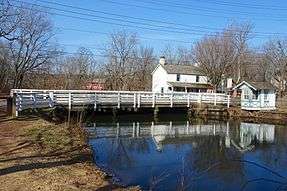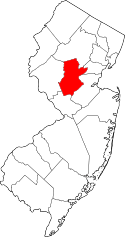Blackwells Mills, New Jersey
| Blackwells Mills, New Jersey | |
|---|---|
| Census-designated place | |
|
Bridge tender's house and bridge leading to Blackwells Mills | |
 Blackwells Mills, New Jersey  Blackwells Mills, New Jersey  Blackwells Mills, New Jersey Location within Somerset County. Inset: Location of Somerset County in the state of New Jersey | |
| Coordinates: 40°29′01″N 74°34′04″W / 40.483582°N 74.567789°WCoordinates: 40°29′01″N 74°34′04″W / 40.483582°N 74.567789°W[1][2] | |
| Country |
|
| State |
|
| County | Somerset |
| Township | Franklin |
| Area[1] | |
| • Total | 1.296 sq mi (3.356 km2) |
| • Land | 1.222 sq mi (3.165 km2) |
| • Water | 0.074 sq mi (0.191 km2) 5.70% |
| Elevation[3] | 89 ft (27 m) |
| Population (Census 2010)[4] | |
| • Total | 803 |
| • Density | 657.1/sq mi (253.7/km2) |
| Time zone | Eastern (EST) (UTC-5) |
| • Summer (DST) | Eastern (EDT) (UTC-4) |
| Area code(s) | 609 and 732/848 |
| FIPS code | 3406025[1] |
| GNIS feature ID | 02583968[1] |
Blackwells Mills is an unincorporated community and census-designated place (CDP) located in Franklin Township, in Somerset County, New Jersey, United States.[5][6][7] As of the 2010 United States Census, the CDP's population was 803.[4]
History
Blackwells Mills is on the east side of the Millstone River in Franklin Township, Somerset County, New Jersey. A mill was built in 1746 by Peter Schenk. His daughter married a Mercer and the mill passed to her family. The mill was purchased by William Blackwell in 1804 with his uncle Capt. Jacob Blackwell. These men were from nearby Hopewell Township. William Blackwell built a fine Federal period house on the land across the road on the Hillsborough side. Following Hurricane Floyd, the house was moved westward to higher ground. It is still standing. Following the death of William Blackwell in the 1850s, his son John came into possession of the mill. John Blackwell died early in life, and his widow sold the mill to Augustus VanZant in 1872. On May 31, 1771 the west bank of the Millstone River became Hillsborough Township, Somerset County, New Jersey.[8]
The mill burned down in 1885 and was rebuilt. A major restoration was done in 1943.[8]
Geography
According to the United States Census Bureau, Blackwells Mills had a total area of 1.296 square miles (3.356 km2), including 1.222 square miles (3.165 km2) of land and 0.074 square miles (0.191 km2) of water (5.70%).[1][2]
Demographics
| Historical population | |||
|---|---|---|---|
| Census | Pop. | %± | |
| 2010 | 803 | — | |
| Population sources: 2010[4] | |||
Census 2010
At the 2010 United States Census, there were 803 people, 238 households, and 218 families residing in the CDP. The population density was 657.1 per square mile (253.7/km2). There were 241 housing units at an average density of 197.2 per square mile (76.1/km2). The racial makeup of the CDP was 69.12% (555) White, 10.96% (88) Black or African American, 0.12% (1) Native American, 17.93% (144) Asian, 0.37% (3) Pacific Islander, 0.00% (0) from other races, and 1.49% (12) from two or more races. Hispanics or Latinos of any race were 4.48% (36) of the population.[4]
There were 238 households, of which 61.3% had children under the age of 18 living with them, 85.7% were married couples living together, 4.6% had a female householder with no husband present, and 8.4% were non-families. 3.8% of all households were made up of individuals, and 0.4% had someone living alone who was 65 years of age or older. The average household size was 3.34 and the average family size was 3.43.[4]
In the CDP, 32.6% of the population were under the age of 18, 5.6% from 18 to 24, 23.0% from 25 to 44, 34.4% from 45 to 64, and 4.4% who were 65 years of age or older. The median age was 40.9 years. For every 100 females there were 94.9 males. For every 100 females age 18 and over, there were 96.0 males.[4]
Blackwells Mills Canal House
The Blackwells Mills Canal House, located at Blackwells Mills Road and Canal Road along the Delaware and Raritan Canal, was built c. 1830s, at the same time as the canal. It was constructed to house the bridge tender, who would open the swing bridge when canal boats came through, then close it to allow traffic to cross over the canal. It is a contributing property of the Delaware and Raritan Canal historic district, added to the National Register of Historic Places on May 11, 1973.[9]
References
- 1 2 3 4 5 Gazetteer of New Jersey Places, United States Census Bureau. Accessed July 21, 2016.
- 1 2 US Gazetteer files: 2010, 2000, and 1990, United States Census Bureau. Accessed September 4, 2014.
- ↑ U.S. Geological Survey Geographic Names Information System: Blackwells Mills Census Designated Place, Geographic Names Information System. Accessed August 23, 2012.
- 1 2 3 4 5 6 DP-1 - Profile of General Population and Housing Characteristics: 2010 Demographic Profile Data for Blackwells Mills CDP, New Jersey, United States Census Bureau. Accessed August 23, 2012.
- ↑ GCT-PH1 - Population, Housing Units, Area, and Density: 2010 - County -- County Subdivision and Place from the 2010 Census Summary File 1 for Somerset County, New Jersey, United States Census Bureau. Accessed February 11, 2013.
- ↑ 2006-2010 American Community Survey Geography for New Jersey, United States Census Bureau. Accessed February 11, 2013.
- ↑ New Jersey: 2010 - Population and Housing Unit Counts - 2010 Census of Population and Housing (CPH-2-32), United States Census Bureau, August 2012. Accessed February 11, 2013.
- 1 2 "Blackwells Mills". Hillsborough Township. Retrieved December 8, 2011.
- ↑ Historic Sites Survey Team (May 11, 1973). "NRHP Nomination: Delaware and Raritan Canal" (PDF). National Park Service.

